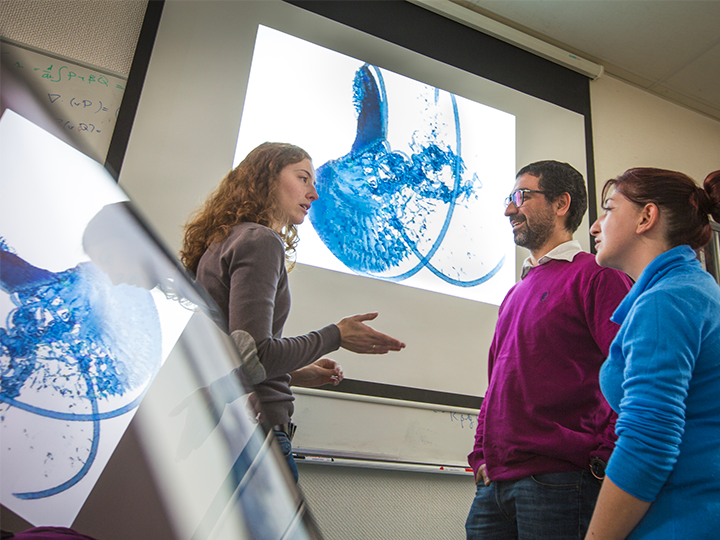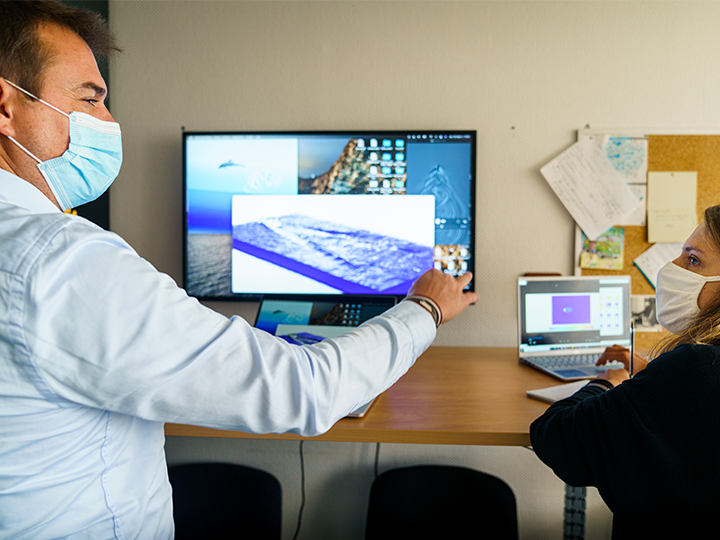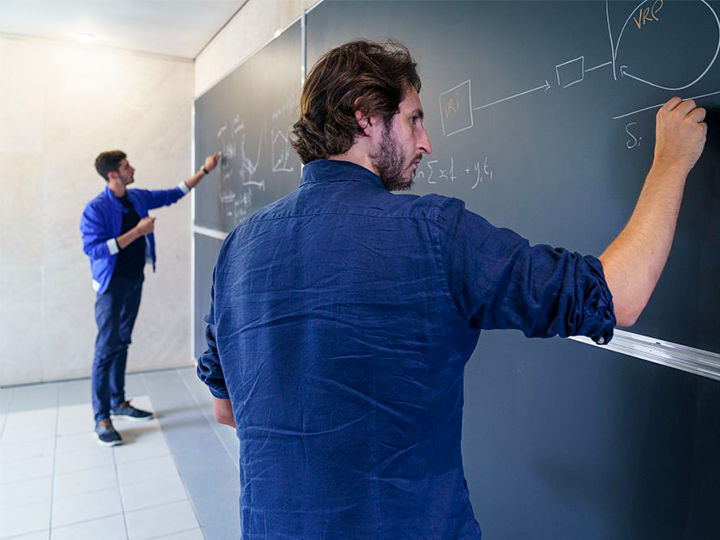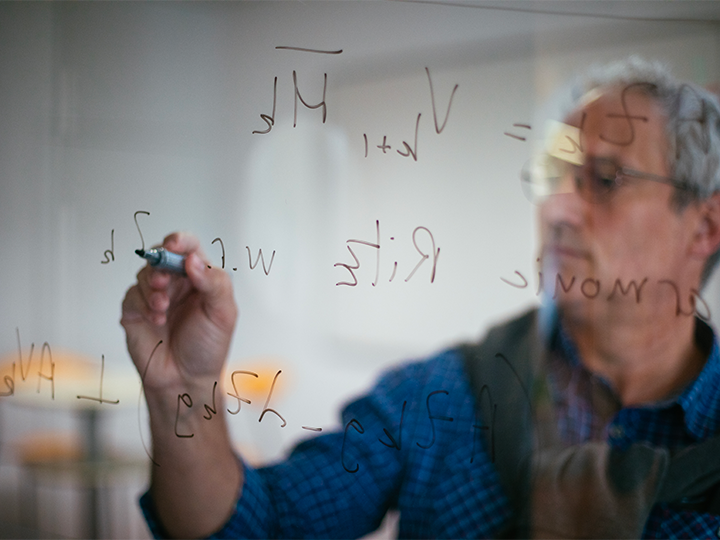
From energy sources to modelling natural resources
Energy sources are essential in our modern society, powering our homes, vehicles and industries, whether they be fossil fuels such as oil and coal, nuclear energy produced from uranium, or so-called renewable energy from sunlight, wind or water. Each energy source has its own advantages and disadvantages in terms of resource availability, environmental impact and cost. While fossil fuels are responsible for the majority of greenhouse gas emissions, renewable energy sources offer a more sustainable and environmentally friendly alternative.
Scientists at the Inria Centre at the University of Bordeaux in the Memphis and Cardamom project teams are working on the study and digital modelling of available natural resources. Whether we're talking about wind or wave energy (produced from a series of waves), for example, there are still many challenges (both technological and scientific) to be met! "In order to design efficient systems for extracting energy from natural resources, we first need to be able to model the sources properly. For example, the quality of the prediction of the effective power of a wind turbine will depend on the quality of the modelling of the wind, and potentially of the atmospheric boundary layer, i.e. the variation in speed, temperature and density with altitude. These phenomena are governed by potentially complex mathematical models," explains Michel Bergmann, a researcher in the Memphis team. "The scientific challenges we are trying to meet revolve around the development of mathematical models and their numerical resolution in order to obtain robust and accurate solutions efficiently. In order to speed up the calculations, we rely on the use of high-performance computing and model reduction, i.e. we will either simplify the models or calculate an approximate solution to a complete model".
Optimising the production of natural energy
Once the energy sources have been correctly modelled, it is possible to look at the actual production of energy, such as the use of wind turbines. "When you drive along the Nationale 10, you can see fields of small wind turbines, around 100 metres high," explains Michel Bergmann. "Each one produces between 3 and 5 megawatts and their positioning in a park optimises energy production. From a scientific point of view, we are contributing at different levels to improve efficiency: we are developing multi-physical (fluid-structure), multi-scale, multi-fidelity models (from a millimetre around the blades to a kilometre for the wind farm) that we use to improve efficiency by acting on the shape of the blades and the relative position of the wind turbines in the wind farm". The Memphis project team is also working on the "wind turbines of the future", which will be bigger than the Eiffel Tower, raising new scientific challenges such as predicting the deformations of the blades (almost 120 metres long) and their impact on production performance.
In addition to wind energy, Inria teams are working on wave energy production, an emerging field with great potential for scientific research. Wave extractors are still underdeveloped, but offer interesting opportunities in terms of optimisation and modelling. "Current technologies using floats are still relatively new and generate less power than wind turbines (only 300 kilowatts)," explains Martin Parisot, a researcher in the Cardamom project team, "However, thanks to the vast range of surfaces where this technology can be deployed, it offers considerable production potential. What's more, it fosters rewarding collaboration between research teams, particularly on issues of optimisation and reduction of environmental impact. We are collaborating with the Memphis project team, which is focusing on local simulations around the float, while at Cardamom we are developing models that are better adapted to wave propagation, making it possible to simulate and optimise float farms".
Stochastic scenarios for efficient energy distribution
Even though natural renewable energies have great potential, scientists need to look at concrete cases to improve energy management. In France, where nuclear power plays a major role, Inria teams are working with many players in the energy sector, including the Edge project team, which is working with EDF and RTE to optimise the management and distribution circuits for the energy produced.
One of the main challenges facing these players is making long-term investment decisions on the electricity network and planning the output of nuclear power plants. "For EDF, for example, planning maintenance outages for its nuclear power plants over a ten-year period is complex because of the uncertainty linked to demand, production and potential failures. We therefore propose methods that ensure the feasibility of production whatever the stochastic scenario in a previously identified set. Similarly, for RTE, the management of uncertainties is crucial in the planning of changes to its network to ensure efficient transmission of energy in the future", explains François Clautiaux, head of the Edge project team.
Numerical modelling of energy management is an essential area of research for guaranteeing a reliable and efficient energy supply. "By working with key players in the sector on the basis of real-life cases, we are helping to answer the complex questions linked to the production and transmission of energy, taking into account the many uncertainties and developing innovative optimisation methods to ensure the robustness of the electricity network," concludes the scientist.
Safety and the environment: the challenges of energy management
The impact of energy on the environment is a crucial issue in modern energy management. The burial and storage of waste, particularly radioactive waste, raises major concerns in terms of environmental impact. "Deep geological disposal, such as that at Bure, requires an in-depth study of the impact on the surface to guarantee long-term safety. To meet these scientific challenges, it is necessary to couple different multi-physical and multi-fidelity models, in order to better understand the processes involved and to ensure adequate monitoring of waste storage", explains Tommaso Taddei, a researcher in the Memphis team.
The protection and safety of facilities such as nuclear power plants is another important aspect of the impact of energy on the environment. Controlling the rate of leakage from a nuclear power plant containment vessel is essential to guarantee the safety of the surrounding population. "It is therefore crucial to achieve convergence between mathematical modelling and real data, using reduced-model techniques to anticipate potential risks and ensure the safety of energy installations upstream," continues the scientist.
Finally, it is important to take into account the impact of pollution on climate change in energy production processes, and this requires atmospheric chemistry calculations to monitor the pollutants emitted. The Concace project team is working in particular on the use of new composite and parallel numerical techniques for large-scale simulations. "This is essential for solving the scientific challenges associated with the resolution of ordinary differential equations (ODEs), which represent the reactions between the different chemical species of the pollutants emitted; these species interact with each other, transform and degrade in the atmosphere. The difficulty is that a multitude of ODE systems need to be solved at each stage of the simulation (to predict the concentration of these species in space over time). At Concace, in collaboration with researchers from our partner Cerfacs, we have used our own resolution techniques, which has enabled us to reduce calculation costs. And this saving is important, particularly in the case of accidents involving chemical production infrastructures, so that information on the surrounding areas affected can be obtained more quickly. The other benefit is that our techniques were more robust and made it possible to manage day/night transitions more effectively, since the mechanisms governing chemical reactions are different in the two cases", stresses Luc Giraud, head of the joint Inria-Industrie Concace project team.
Pour aller plus loin :

Désassemblons le numérique



